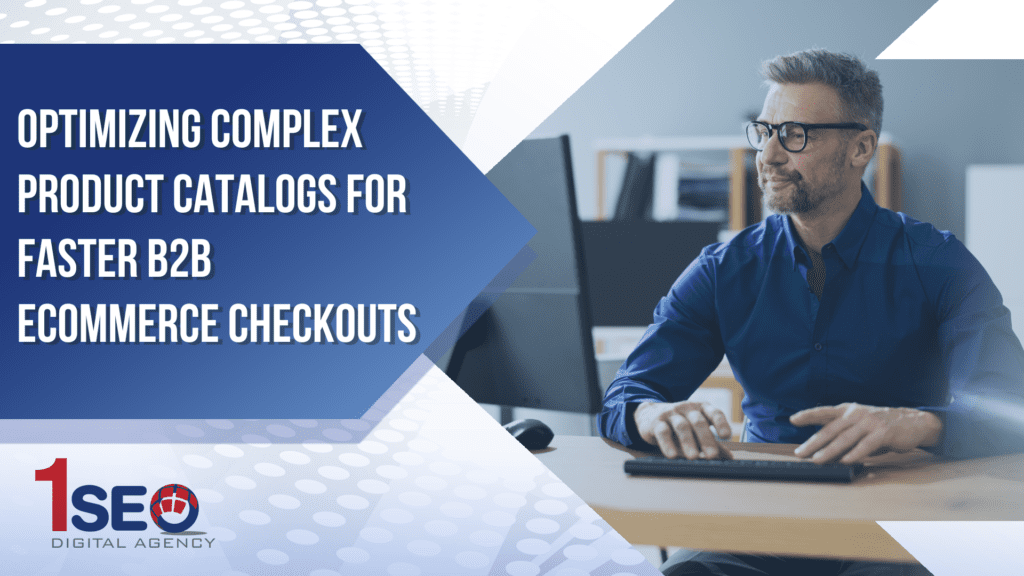Speak To An Expert Now: 215-946-1046
Do Lawyers Dream of Electric Mail?
Does any business based around providing legal services, up to and including Law Firms themselves, use email for focused marketing purposes? To maintain our position

In the digital era, B2B ecommerce has evolved into a powerful engine for business growth, enabling brands to streamline procurement, improve customer satisfaction, and maximize revenue. Unlike B2C, B2B ecommerce involves more complex buying cycles, larger average order sizes, and nuanced customer requirements. This complexity often manifests in extensive product catalogs with detailed specifications, tiered pricing, and customer-specific contracts. Consequently, optimizing these catalogs for a seamless ecommerce checkout experience becomes imperative for enhancing user experience, reducing cart abandonment, and driving sales.
The modern B2B buyer expects the same convenience and speed that consumers enjoy in B2C environments. With the integration of advanced digital commerce platforms like Magento, BigCommerce, and Salesforce Commerce Cloud, B2B brands can achieve this standard. However, the path to optimization is layered—requiring attention to personalization, automation, inventory management, and omnichannel consistency.

Product catalogs are the backbone of any ecommerce platform. For B2B businesses, these catalogs must accommodate thousands of SKUs, varied contract pricing, multiple vendors, and regulatory compliance needs. This complexity, if not managed effectively, can hinder the checkout flow, negatively impacting the customer experience and ultimately, customer retention.
The core challenge lies in presenting vast amounts of product information clearly and concisely while enabling fast product discovery and selection. A well-structured catalog not only enhances navigation but also supports scalability, upselling, and efficiency. To support this, ecommerce strategies must include robust product information management (PIM) systems that centralize data, standardize descriptions, and maintain visibility across touchpoints.
Personalization is no longer optional in digital commerce—it’s a key driver of customer satisfaction and loyalty. By leveraging analytics and customer behavior data, B2B brands can tailor product recommendations, pricing, and content to align with each customer’s specific needs. This includes displaying relevant SKUs based on purchase history, contract terms, and company size, or integrating predictive algorithms to suggest complementary items during the checkout process.
Understanding the behavior of the target audience allows businesses to adapt their ecommerce checkout process to their preferences. For instance, if data reveals a high mobile commerce adoption rate, the user experience should prioritize mobile device optimization. Additionally, the inclusion of chatbot support can provide real-time assistance, reduce friction, and increase confidence in purchasing decisions.
A fast and intuitive checkout flow is essential for reducing cart abandonment and increasing conversion rates. In B2B ecommerce, the checkout process often involves additional steps such as purchase order entry, trade credit validation, invoicing, and authentication protocols. Simplifying this experience while preserving the necessary controls is a balancing act.
Guest checkout options can reduce entry barriers for first-time buyers, while saved preferences and auto-fill capabilities can enhance returning customer efficiency. Integration with various payment gateways, including digital wallets like Apple Pay, helps diversify payment options and accommodate customer preferences. These enhancements reduce friction, elevate the shopping experience, and support customer lifetime value.
Offering a wide array of payment solutions is critical for B2B transactions. Trade credit is a standard practice in the B2B market, enabling businesses to place orders and defer payments, which supports cash flow management. Integrating trade credit functionality into the ecommerce checkout process ensures a smooth and trustworthy experience for the buyer.
The payment process must be secure, efficient, and transparent. By integrating advanced payment gateways that support multiple currencies, payment terms, and invoicing automation, companies can serve international customers with ease. Additionally, offering options like credit cards, ACH transfers, and digital wallets expands the customer base and enhances the overall convenience of online shopping.
PIM systems play a pivotal role in ensuring that accurate and up-to-date product data is available across all channels. They help in managing complexity by consolidating data from multiple sources, enriching product content, and distributing it consistently. This reduces errors, improves confidence, and facilitates quick product selection—critical during high-volume purchasing periods.
For instance, if a vendor changes specifications or pricing, a PIM ensures that this information is reflected in real-time across the ecommerce platform. This accuracy is vital not just for customer trust but also for regulatory compliance, especially in industries with strict product standards.
The design of an ecommerce site greatly influences user experience and behavior. B2B ecommerce platforms must prioritize clarity, responsiveness, and ease of use. This includes logical categorization of products, powerful search capabilities, and intuitive navigation paths that guide the user to the checkout with minimal distractions.
Implementing features such as dynamic filtering, detailed product comparisons, and rich media (e.g., 360-degree product views) can enhance the online shopping experience. Clear calls to action, progress indicators during checkout, and real-time inventory updates contribute to transparency and confidence, encouraging repeat purchases and fostering brand loyalty.
Today’s customers interact with brands across various channels—web browsers, mobile devices, in-person sales teams, and even voice assistants. An effective B2B ecommerce strategy must ensure omnichannel consistency, where the experience is seamless regardless of the touchpoint. This involves synchronizing customer data, order history, inventory status, and product content across all platforms.
For example, if a customer begins a purchase on a mobile device and completes it via desktop, their cart contents and pricing details should remain consistent. This level of cohesion boosts customer confidence, supports loyalty programs, and helps maintain visibility throughout the buying journey.
Automation and artificial intelligence are transforming ecommerce checkout optimization. AI-driven tools can analyze customer behavior in real time, identify friction points, and recommend layout or process adjustments. Automation streamlines backend operations like inventory updates, order processing, and tax calculation, reducing human error and accelerating fulfillment.
Additionally, AI can power intelligent upselling and cross-selling during the checkout phase, increasing average order value without disrupting the flow. Chatbots and virtual assistants can answer last-minute questions, reduce reliance on customer service, and guide the consumer through to purchase completion.
Security remains a top concern in ecommerce, especially with the rise of mobile commerce and digital wallets. B2B transactions often involve large sums, necessitating stringent fraud detection, authentication mechanisms, and data encryption. Multi-factor authentication, secure sockets layer (SSL) certificates, and tokenized payment methods help safeguard the checkout flow.
Furthermore, fraud prevention tools that utilize behavioral analytics can identify suspicious activity and trigger verification processes. Ensuring regulatory compliance, particularly with data protection laws, is essential for maintaining trust and protecting company information.
Data is the cornerstone of continuous improvement in ecommerce. With advanced analytics, B2B companies can gain deep insights into customer behavior, checkout performance, product demand, and lead quality. This information guides strategic decisions related to pricing, inventory management, and digital transformation initiatives.
For instance, if analytics reveal frequent cart abandonment at the payment step, this may indicate issues with the payment gateway or unexpected costs such as tax or shipping. Addressing these friction points can lead to significant improvements in revenue and customer retention.
Trust is a critical component of the B2B purchasing process. Incorporating social proof such as testimonials, case studies, and reviews into the shopping cart and checkout pages can reassure potential buyers and validate the product’s value. Showcasing vendor credentials, certifications, and customer logos further enhances credibility.
Moreover, proactive customer support—through live chat, dedicated account managers, or AI-powered help desks—ensures that buyers receive assistance at every stage. This support not only resolves issues quickly but also reinforces a company’s commitment to customer service and satisfaction.
As businesses grow, so does the need for scalable ecommerce solutions. Platforms like Magento, BigCommerce, and Salesforce offer the infrastructure to handle expanding product lines, increasing traffic, and complex pricing models. Ensuring that the backend architecture can support growth is essential for maintaining performance and reliability.
This includes investing in flexible software solutions, optimizing server performance, and integrating APIs for seamless communication with supply chain partners. Scalable systems also facilitate global expansion, enabling brands to enter new markets with confidence and agility.

Enterprise resource planning (ERP) and customer relationship management (CRM) systems are foundational technologies in the digital transformation of B2B ecommerce. These platforms synchronize vital business functions—from procurement and inventory to customer data and payment terms—into a single source of truth. When integrated properly with platforms like Magento, BigCommerce, or other enterprise ecommerce systems, they streamline catalog updates, pricing logic, and the checkout flow.
For example, by linking Salesforce with your ecommerce platform, customer-specific pricing, trade credit availability, and purchase order preferences can automatically populate during checkout. This removes friction, increases customer satisfaction, and ensures a more personalized customer experience. It also enhances data visibility, ensuring that product availability, tax compliance, and contract terms are always accurate at every touchpoint. This kind of system integration supports efficiency in order fulfillment and empowers B2B brands to scale with confidence.
As digital commerce breaks geographic boundaries, localization becomes a key component in ecommerce checkout optimization. B2B ecommerce businesses operating in international markets must adapt product catalogs, payment options, and checkout interfaces to match the language, currency, tax rules, and procurement customs of each target audience.
Dynamic pricing engines can automatically apply region-specific price adjustments based on location, while localized content boosts search engine results page performance and brand credibility. Integrating multi-currency payment gateways and aligning checkout logic with local regulations not only supports compliance but also reduces cart abandonment and builds customer confidence. Furthermore, localized digital wallet options like Apple Pay and region-specific invoicing reinforce customer trust and streamline the overall shopping experience across mobile devices and web browsers.
Inventory management in B2B ecommerce is a balancing act between demand forecasting, order fulfillment, and logistics efficiency. Real-time inventory synchronization across catalogs ensures that your product availability data is always accurate, regardless of the channel—whether it’s your ecommerce site, mobile app, or external online marketplace like Alibaba Group.
When integrated with ERP systems, inventory visibility extends from warehouse management systems to front-end checkout interfaces. This reduces the risk of overselling, backorders, and delivery delays, all of which negatively affect customer retention and revenue. Inventory transparency also supports upselling by suggesting in-stock complementary items during the checkout flow. Predictive analytics based on current inventory levels can further personalize product recommendations, boosting gross merchandise volume and reinforcing a positive customer experience.
With catalogs spanning thousands of SKUs, B2B ecommerce companies need powerful, intelligent search tools to help users find the right products quickly. Leveraging AI-enhanced search, machine learning algorithms, and behavior-based filters can drastically reduce time-to-purchase and drive ecommerce checkout optimization.
Custom filters, dynamic sorting, and auto-suggestions improve product discoverability, enhancing usability and user experience. Backend integration with product information management (PIM) systems ensures that search results reflect the most current product descriptions, prices, and availability. Intelligent search functionality not only supports customer retention but also directly increases lead quality and conversion rates by aligning results with the buyer’s intent and organizational purchasing behavior.
The rise of mobile commerce in the B2B sector reflects a growing demand for flexibility, convenience, and always-on access to purchasing tools. Whether through a mobile-optimized website or a dedicated mobile app, a responsive design is critical to ensuring seamless functionality across all screen sizes and devices.
Mobile-specific features such as biometric authentication, one-tap payments via Apple Pay, and persistent shopping carts ensure a fast and secure checkout experience. Combined with mobile-optimized search, intuitive interfaces, and fast-loading pages, these elements reduce bounce rates and support brand loyalty. Mobile-friendly ecommerce checkouts also enhance accessibility, accommodating users who manage procurement on-the-go, increasing operational efficiency and customer service responsiveness.
Google Shopping and online advertising strategies play a vital role in ecommerce SEO and catalog visibility. When optimized correctly, your product feed can appear directly on search engine results pages, allowing decision-makers to discover your offerings during the research phase. This boosts brand awareness and generates qualified ecommerce leads.
Digital advertising campaigns on platforms like Google Ads and LinkedIn allow for targeted advertising to key segments of your target market. By aligning landing pages with ad copy and integrating social proof elements, you can nurture leads more effectively and direct them into a streamlined checkout process. The use of analytics to measure campaign performance supports continuous improvement and increases the return on investment in your ecommerce marketing strategy.
B2B ecommerce purchases are often governed by unique pricing contracts and complex organizational structures. Enterprise software solutions allow you to implement contract-based pricing rules that dynamically adjust based on the customer’s account, purchase volume, or negotiated terms.
Role-based access ensures that only authorized personnel can approve purchases, apply trade credits, or place large-volume orders. This supports compliance with internal procurement protocols and reduces the risk of error or fraud. Configuring your ecommerce platform to support these enterprise workflows enhances transparency, builds credibility, and fosters long-term relationships with customers by aligning your checkout experience with their operational expectations.
Loyalty programs are not just for B2C; they’re a powerful tool in B2B ecommerce marketing. By incentivizing repeat purchases with rewards, exclusive discounts, or tiered membership benefits, companies can increase customer lifetime value and improve retention.
Integrating loyalty program logic into the checkout flow allows customers to apply rewards or discounts in real time, encouraging immediate conversions. The data collected through loyalty programs can inform personalization efforts and support predictive analytics, helping ecommerce brands tailor offers and promotions to high-value customers. This creates a compelling ecosystem where loyalty, behavior, and checkout optimization work in tandem to drive profitability.
The customer journey doesn’t end at checkout—post-purchase touchpoints are crucial for reinforcing trust and driving repeat business. Automated email marketing campaigns can confirm orders, provide tracking updates, and offer personalized recommendations for reordering.
Branded order confirmation pages, customized packing slips, and efficient order fulfillment updates build credibility and foster a sense of professionalism. Post-purchase surveys and testimonial requests offer valuable feedback and generate social proof that can be used to improve your product catalog and inform advertising strategies. These touchpoints increase brand visibility and loyalty, positioning your company as a reliable partner in the digital economy.
Understanding how customers interact with your ecommerce site is essential for optimizing the checkout flow. Tools like heatmaps, session replays, and behavioral analytics help identify pain points in the user journey—such as friction areas in form fields, unclear call-to-action buttons, or unexpected costs in the cart.
Data from these tools informs A/B testing strategies, web design decisions, and mobile optimization efforts. Combined with insights from CRM systems and marketing automation platforms, heatmap analytics support a more intuitive and confident shopping experience. By reducing cognitive load and improving interface design, businesses can minimize cart abandonment, increase conversion rates, and achieve a higher return on investment.

Optimizing complex product catalogs and streamlining the B2B ecommerce checkout process requires not only the right technology, but also the right digital strategy. That’s where 1SEO Digital Agency comes in. As a trusted leader in digital marketing and ecommerce development, 1SEO specializes in helping B2B brands accelerate growth, improve customer experience, and enhance digital efficiency.
With a deep understanding of ecommerce challenges—from product information management to payment gateway integrations—1SEO empowers businesses to transform their digital commerce operations. Whether you’re running on Magento, BigCommerce, Salesforce, or another platform, we have the expertise to tailor scalable, high-converting ecommerce solutions that meet your exact needs.
At 1SEO, we combine innovative design, strategic thinking, and technical expertise to elevate your ecommerce operations. Let us help you reduce friction, maximize revenue, and create a seamless shopping experience that keeps your customers coming back.
Ready to enhance your B2B ecommerce strategy? Partner with 1SEO Digital Agency—the go-to agency for ecommerce success.
Does any business based around providing legal services, up to and including Law Firms themselves, use email for focused marketing purposes? To maintain our position

Lead generation is the process of attracting potential customers to a business. This process typically begins with marketing activities such as creating an optimized website